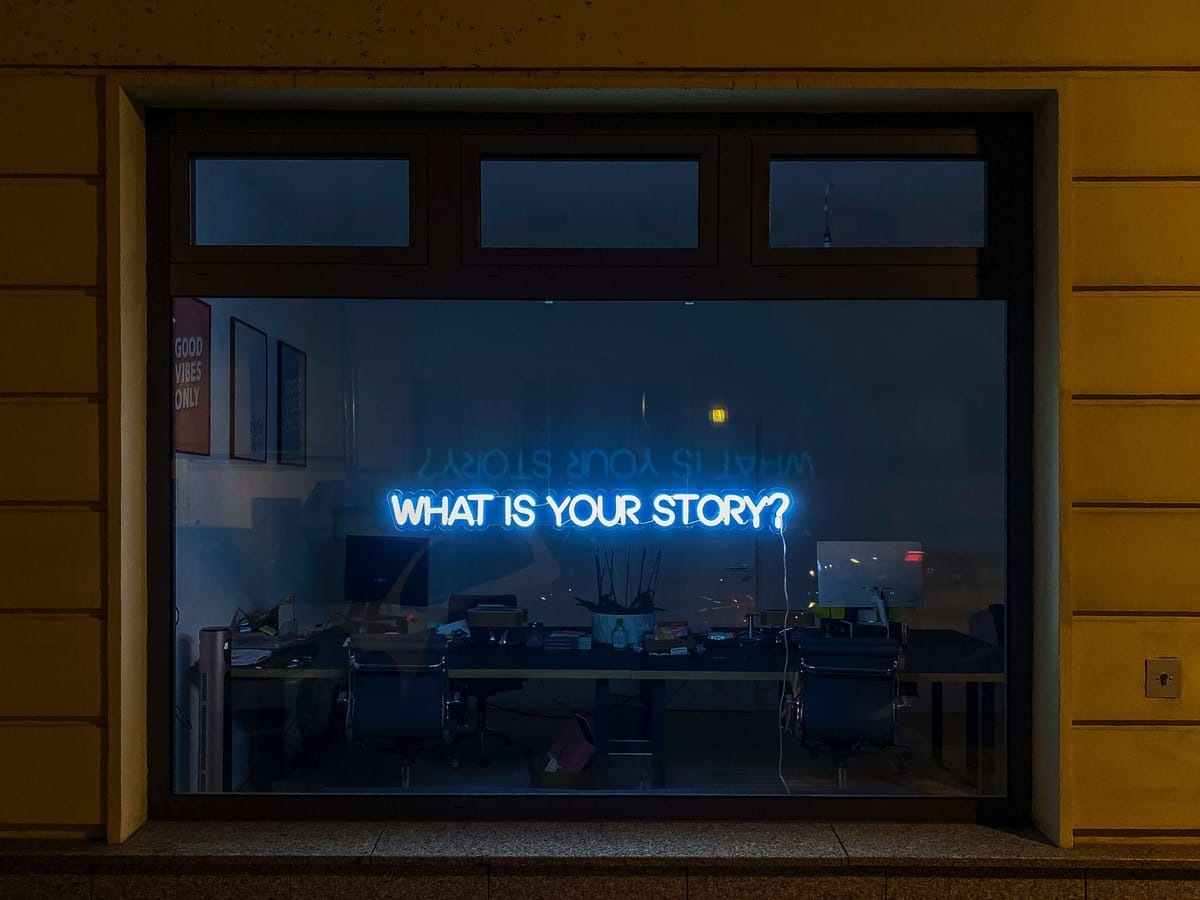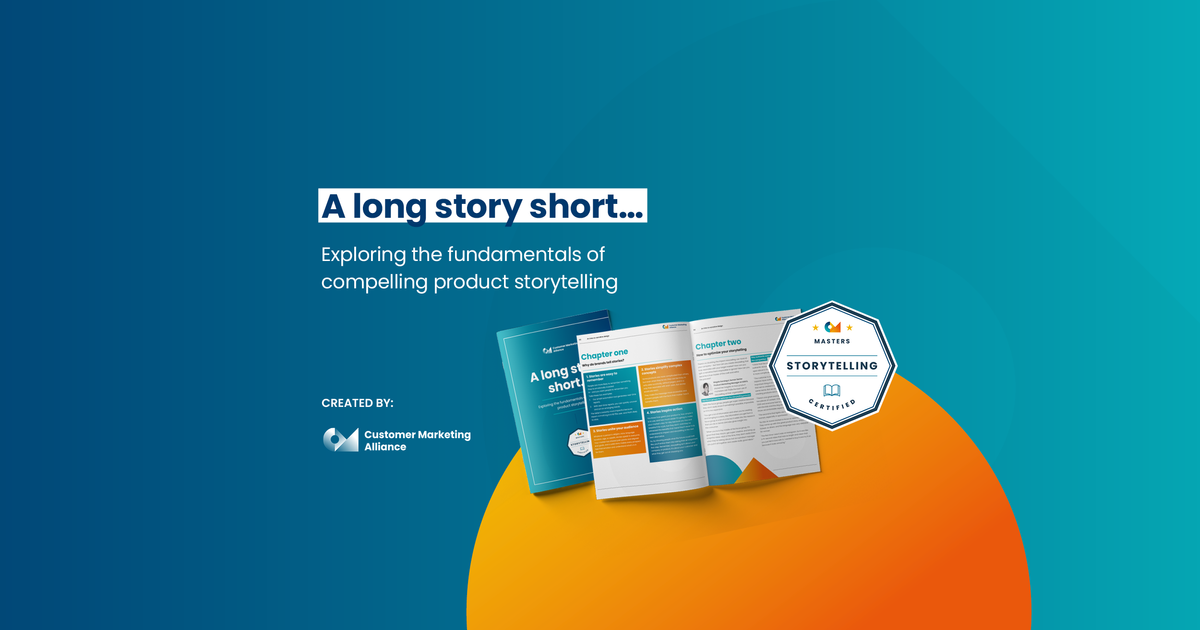Brand storytelling is the act of crafting stories that connect emotionally, fostering brand loyalty and deeper connections. In this guide, you’ll find our current resources from articles, ebooks, and courses to help you become a master storyteller for your brand.
Specifically, we’ll be looking at:
- What brand storytelling is
- Why it’s important
- Why you should use brand storytelling
- How brand storytelling impacts brand image
- How to use brand avatars and the hero’s journey
- The impact of emotional storytelling
- How storytelling works to support advocacy
- Some examples of great brand storytelling
What is brand storytelling?
Brand storytelling (as noted in our comprehensive customer marketing glossary) is the use of a brand's values, purpose, and identity to create compelling narratives that captivate the target audience. It involves crafting stories that connect emotionally, fostering brand loyalty and deeper connections.
These narratives typically follow a structure with a beginning, middle, and end, organizing elements like plot, characters, and conflicts. Brand stories can explore ideas, beliefs, experiences, and events, often featuring a change that concludes positively or negatively.
These stories can be delivered through various means, including spoken word, written text, visuals, or multimedia.
Why is brand storytelling important?
From the perspective of the customer, your brand storytelling should show them the result of their investment in your brand. Sometimes it can be easy to get lost in new metrics, platforms, and ways to perform marketing, but in the end, marketing is all about influencing someone to do something.
Stories are the most influential way of conveying the value your brand has, and building a story with a relatable ‘hero’ is a fantastic way to get your customers to buy into your product.
Charlotte Lilley, Head of Global Customer Marketing at Coupa noted that:
“At Coupa, we focus on telling stories that showcase our customers and how they're using our products and services to achieve their goals. Here we are strategic with how we go about this and we have specific people on the team working on specific segments.”

So, in what context should stories be used? Generally speaking, there are a few common reasons why storytelling is used:
- - Promote a product
- - Entertain your audience
- - Showcase an achievement or landmark
- - Educate the market or existing customers about a new product, feature or service
Each of these reasons will be showcased differently depending on who you’re targeting. Things that’ll impact the type of story you tell are things like:
- Customer segments
- Customer journey touchpoints
- Product and/or feature uses
- Customer lifetime value
Questions to ask for story choices
Your brand story must be clear about who it wants to connect with, otherwise, the effort put into making an emotional connection becomes useless. A customer isn’t going to want to hear about stories that don’t matter to them.
So, to make sure you’re on the right track ask yourself these questions:
- Who is this story for? Who will be most receptive to it and why?
- What is the story’s purpose? Is it to educate? About what? (product, release, feature)
- What is the key message of the story - can it be distilled in one concise sentence?
- What action do we want the audience to take? Upgrade membership, share a post, or book a demo?
- Which medium will be the best to showcase the story?
Also, think about how you want it presented. Will it be in traditional advertising form, a case study experience, or something else? Getting customers involved themselves is often a strong way to make immediate connections between current and potential customers, and supports other aspects of the customer marketing process to boot!
Why use brand storytelling?
So why use storytelling specifically? Why not use other tools for customer outreach like reference, advocacy, swag etc.? While those have their place, storytelling is a practice that is innately human and has been done for centuries.
As Gastón Tourn, CMO of Curio says:
“Some principles have been true for thousands of years, and there's so much we can learn – not just marketers, but anyone in business. Storytelling is a critical skill for fundraising, presenting to boards of investors, and negotiating a promotion too.”
Gaston goes on to explain that while you can do the basics of showing how your product works, that’s never going to be enough. In today’s marking landscape that’s not just the bare minimum, it won’t even get you noticed.
Hundreds of other companies will be selling similar products and experiences, so storytelling (and creating a solid and identifiable brand image) is the only way to get your noticed and distinguishable from your competitors:
“Marketing stories cannot just illustrate what the product does; they need to elevate the product experience. A marketing advert that just illustrates in very practical terms what a product does is going to have some effectiveness, but it’s not going to tell a compelling story about the brand and so it’s not going to build the brand.
If you just show the product and how it works, your advert is going to be quite dull, but if you defamiliarize it and you show that experience, it captures people's imagination and creates a much stronger emotional connection with the product.”
Want to read the whole interview? Take a look below.

How brand storytelling impacts brand image
Brand storytelling is a powerful vehicle for communicating brand values and personality, helping customers develop a clearer understanding of what your brand represents.
Stories also build your company up as genuine and trustworthy which goes a long way into building - and becoming worthy of - lasting consumer advocacy. And, as we’ve mentioned before, unique brand stories act as differentiators within the crowded market, ensuring you stand out from your competitors.
Brand storytelling changes the way customers perceive and interact with your company, turning a simple transaction into a meaningful experience and enhancing your overall brand image.

Brand avatars and the hero’s journey
Brand avatars, also known as an Ideal Customer Avatar (ICA) is a detailed character profile that illuminates the core benefits of your product or service. Storytelling must invite customers to envision an improved version of their own story.
The ICA is the ‘protagonist’ in the hero’s journey. But to craft this narrative effectively, marketers must first deeply understand the current state of their audience's lives, challenges, and unfulfilled aspirations.
As marketers, you are both the guide and narrator, to your ICA. Your storytelling will showcase the wisdom and tools necessary for your ICA's personal development story.
The Hero’s journey
There are a ton of different kinds of plots you can use to implement into your own storytelling, but the most classic story arc is known as The Hero’s Journey. Once you know about it, you’ll see it everywhere: The Lion King, Star Wars, The Fellowship of the Ring, and more.
The Hero’s journey has eleven plot beats:
- 1 - The Ordinary World
- 2 - The Call to Adventure
- 3 - Refusal of the Call
- 4 - Meeting with the Mentor
- 5 - Crossing the First Threshold
- 6 - Tests, Allies, and Enemies
- 7 - Approach to the Innermost Cave
- 8 - The Ordeal
- 9 - The Reward
- 10 - The Road Back
- 11 - The Ressurection
- 12 - Return with the Elixir
This stuff is just the tip of the narrative design iceberg, so don’t just leave your understanding here where our Narrative Design: Masters is ready to make you the next Shakespeare of marketing stories.

Now these may not mean a lot on their own, so we’ve got an example for you from The Lion King. The plot beats go as follows:
- The Ordinary World: Simba is the heir to the throne of Pride Lands.
- The Call to Adventure: Scar kills Mufasa and tells Simba to leave Pride Lands.
- Refusal of the Call: Simba, scared and alone, retreats to the desert.
- Meeting with the Mentor: Timon and Pumbaa introduce Simba to life in the jungle.
- Crossing the First Threshold: Simba embraces the “hakuna matata” lifestyle.
- Tests, Allies, and Enemies: Nala finds Simba and they fall in love.
- Approach to the Innermost Cave: Nala asks Simba to save the Pride Lands and reclaim the throne.
- The Ordeal: Simba must decide between his life in the jungle and his duty to the Pride Lands.
- The Reward: Mufasa’s ghost tells Simba to return.
- The Road Back: Simba goes with Nala and faces off against Scar.
- The Ressurection: Simba learns Scar killed his father and he throws Scar from Pride Rock.
- Return with the Elixir: Simba ascends Pride Rock and reclaims his throne.
Lots of stories have similar protagonists, similar journeys, and similar obstacles, but are still unique in their own right. The Lion Kings itself is well known to be a loose adaptation of Shakespeare’s Hamlet, but you wouldn’t see people arguing Simba and Hamlet are the same character. So even with this most basic structure, you’ll be able to build a host of customer stories upon it.
We also go through more nuanced story structures, including the six basic plots in this article:

Emotional storytelling
As we’ve established throughout this guide, storytelling has the goal of persuasion but must be able to connect to the individual interacting with it, usually through emotional storytelling.
Here are some tips on engaging in emotional storytelling.
Leverage powerful sensory details
Senses include smell, sight, sound, taste, and touch. Some of these can be more ticky to convery through a traditional medium, but perfum advertisers have been doing it for decades. The main key is to pick a sense that you want to focu on, and engage the imagination of the customer through vidual or auditory storytelling.
By engaging multiple senses, you can make narratives more vivid and emotionally impactful. But how do you apply this? Here are some examples:
- A coffee company: A coffee brand could weave rich sensory details into their narrative about their sourcing and roasting process. They might describe the misty mountains where their beans are grown, the earthy aroma that fills the air during roasting, or the smooth, velvety texture of the final brew.
- A luxury car manufacturer's promotional campaign: A high-end car brand could use sensory storytelling to convey the experience of driving their latest model. They might detail the touch of hand-stitched leather, the satisfying click of precision-engineered controls, or the purr of the engine as it comes to life.
By incorporating such vivid sensory details, marketers can create more engaging and persuasive brand stories that stick in customers' minds and evoke emotional responses. This approach helps to differentiate the brand and create a more immersive, memorable customer experience.
layer in emotional punches through subtle symbolism, character actions, visual metaphors – all manner of showing rather than telling.
Build towards an emotional catharsis
Make sure to build towards an emotional catharsis or release for the audience. Arouse feelings scene by scene, then resolve them in a culminating way that leaves people feeling cleansed and satisfied, even if tinged with lingering sentiments. An abrupt non-ending is deeply unsatisfying.
Here are two examples of what we mean:
A fitness app
This ad can tell of a working mother struggling with self-image and health issues. The narrative would detail her frustrations, self-doubt, and failed attempts at getting fit. As she discovers the app, the story would follow her journey - the early morning workouts, moments of wanting to give up, and small victories.
The emotional tension builds as she faces her biggest challenge: a local 5K race she's always dreamed of completing.
The catharsis comes when she crosses the finish line, tears streaming down her face, realizing she's not only achieved her fitness goal but also rediscovered her strength and confidence. This emotional peak allows customers to experience the triumph vicariously through the character, associating those feelings with the brand.
A sustainable fashion brand's ethical awakening story
The brand could narrate the journey of its founder, who started in the fast fashion industry. The story would describe their growing unease with the industry's wasteful practices and exploitation. Tension builds as the founder grapples with ethical dilemmas, risking their career to speak out against harmful practices.
The cathartic moment arrives when the founder decides to leave their high-paying job to start an ethical, sustainable fashion line. This decision, though difficult, brings a sense of relief and purpose.
The story culminates in the brand's creation, offering customers a way to participate in this ethical transformation and experience the emotional release of aligning their values with their fashion choices.
Avoid performative activism
One key area where brands often struggle with ethos is around social and political issues like LGBTQ+ rights or racial equality. Don’t cut corners by engaging in "performative" support that’s shallow or misaligned with your brand's actual practices.
A lot of brands get this wrong. You see it all the time during Black History Month and Pride Month. Many brands do performative support during those moments, but it's not going to get them very far. People spot it very quickly when that support is purely performative and there's no real commitment to standing for those values.
As Erin McLean, CMO at eSentire, puts it:
“You have to give people an opportunity to connect and understand the people behind those messages - we all live in would have been connection. Understanding, connection, awareness, engagement, and all those key buzzwords help you move through a funnel, and make you understand that you are resonating with your target audience.”
How brand storytelling supports advocacy
All of the points we’ve already talked about go a long way to helping connect with your audience. But with advocacy specifically, we want to hit on the two following points.
1 - Be consistent and authentic
This may seem like a moot point, but you’ll be surprised how tempting it can be to drop consistency and authenticity when big dollar signs are flashing at you.
There may be tempting to over-promise to a potential client, or make unique changes to cater toward specific deal, but this never works in the long run. Cracks will start to show very quickly, and the relationship will be ruined before it’s ever even truly begun.
As we mentioned with performative action, customers don’t like false promises or pretty works - they’re not stupid, they’ll see through the ruse quicker than your think!
So make sure you’re starting your customer relationships the right way from the very first ad that comes across their ‘for you’ page. Deliver exactly what you know they’ll get when buying from you.
2 - Make your advocates the heroes
With what we’ve said in this guide so far, we’ve stuck to a very brand-first outlook. Brand storytelling connects with customers mainly for the support of your business. While this remains true, one of the best ways to ensure advocacy is to make your customer the ‘main character’.
Whether this is in a fictional customer journey or a real-life case study, the main aim is to put your customer in the spotlight - in turn, it'll naturally put attention onto your brand as well.
As Miri Rodriguez, in the book, "Brand Storytelling: Put Customers at the Heart of Your Brand Story", describes it:
“The brand takes on the role of sidekick in its own story, commissioning the customer to prosper with its help […] when the customer understands that your brand exists to make them better in one way or another and that you are positioning them to win, they become especially interested in winning. And when they win, you win.”

Many of the concepts we’ve spoken about naturally encourage brand loyalty and advocacy, but none of these can be done well without actually connecting with your audience.
Placing your customers as the ‘Batman’ in your brand story does no good if the narrative goes somewhere your audiences don't connect with.
Listen to criticism, make it a habit to conduct case studies and form focus groups. Offer the right kinds of incentives by asking your audience what they want from the narrative. All of this information can go towards forming the most authentic and satisfying narrative for your brand.
Consider where the story might go next by identifying the causes, features, or upgrades your customers are most curious about - don’t be afraid to highlight these changes too. Make a sequel to your original story!
How to build a brand story
So, where do you begin with this kind of detailed project? Liz Greer and Jazmyne Todd, suggest the following three steps:
Step one: Drive internal alignment
Begin with you! The first step in building a brand story according to Liz and Jazmyne is to understand your marketing priorities and drive alignment across teams to select the most strategic customer stories. Consider your overall marketing strategy, company narratives, and important marketing moments for the year.
They also urge to work with other teams for picking customer stories and have them nominate their own favourites.
Step two: Strategize on how and where to share customers' stories
The next step is to partner across your business to create a cohesive co-marketing journey across all of your content and channels. They suggest (if you haven’t got one already) forming a single marketing contact for the customer to ensure a unified approach and the best customer experience.
Develop the co-marketing journey and make sure to pinpoint the customer's goals and priorities to position your storytelling opportunities in a way that’ll excite and delight them.
Step three: Scale and promote content across channels
Know where to show your stories! Provides platforms to share authentic stories through various means, such as filmed demos, executive interviews, and films.
Scale your story to reach your customers through multiple channels and formats. Make sure to develop internal communication strategies as wel as social media to expand the reach of the marketing story to new audiences.
Is this guide just not enough? Don’t worry, we’ve got you covered. This eBook explores the fundamentals of compelling product storytelling so you don’t miss a beat:

Examples of great brand storytelling
We’ve already got a pretty comprehensive article on five notable examples of brand storytelling, so we’ll try not to repeat ourselves too much. Here’s the article below:

But if you want a speedy overview of some of the examples, you’re in the right place!
First is the Always' "Like a Girl" campaign from 2014, which challenged the negative connotations of the phrase "like a girl." This campaign created an emotional connection with viewers and sparked social media engagement, aligning with the brand's values of empowering women and girls.
Next is Nike's "Find Your Greatness" campaign from 2012, which inspired everyday athletes to pursue their goals. It featured an overweight runner running at dawn. This simple story (made with no dialogue) not only directly challenged stereotypes on exercise, but also reinforced Nike's "Just do it" slogan and core values.
The third example is M&M's use of their red and yellow M&M's characters. These memorable mascots have been used in long-running campaigns, creating humorous scenarios to keep the brand in the public consciousness and allowing for versatile storytelling across various advertisements.
The use of bright colors and personalities makes the brand instantly identifiable by these fictional characters.
All of these campaigns effectively use storytelling to connect with their target audiences, reflect brand values, and create memorable, emotionally resonant content.
If you want to truly understand the science behind fantastic stories like the ones above, our Storytelling: Masters and its tutor, Eliot Raynar, are just what you’re looking for.
By the end of the course, you'll be able to:
- Construct an actionable storytelling framework.
- Tailor your story like a pro.
- Authentically connect with your customers through a story.
- Communicate to your audience with confidence and passion
- Use your purpose to ensure your story remains consistent.
- Have an impactful change on your approach to story and success.












